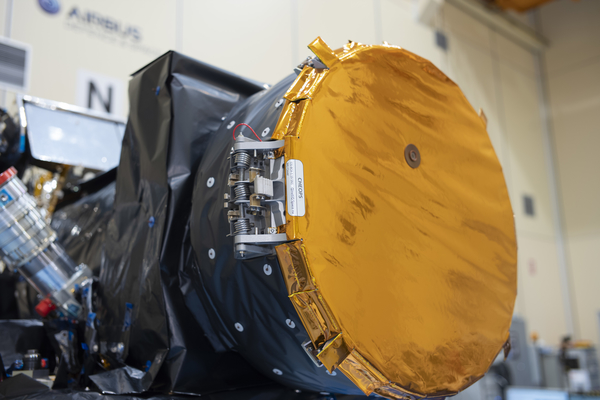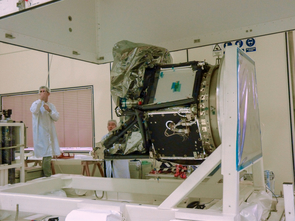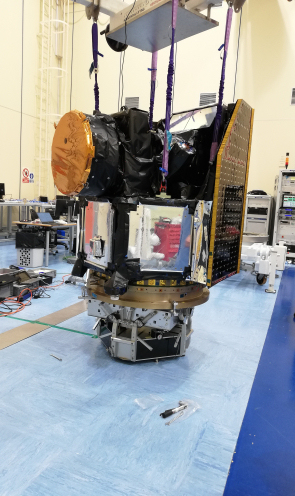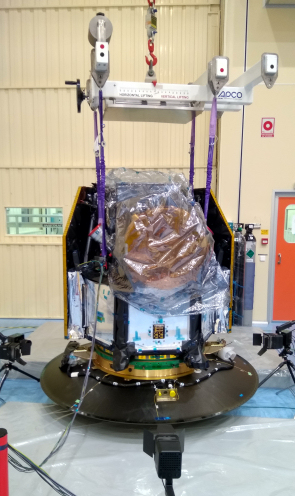#16: CHEOPS is ready for flight
11 March 2019
Recent months on the CHEOPS mission have seen the completion of spacecraft testing and the conclusion of a very important review, which determined that the satellite is ready to fly. |
| CHEOPS in the clean room. Credit: ESA – S. Corvaja |
The intellectual DNA of a space project is bundled up in the many documents that define what is required of a mission to achieve its goals. Ambitious scientific objectives cascade down into a dense hierarchy of first scientific and then engineering requirements that govern the satellite's systems and sub-systems. In the end, the spacecraft can only be declared ready for launch when it complies with hundreds of well-chosen requirements, and compliance is verified by testing.
For CHEOPS, it has taken over five years of hard work to get to this point. Readers of this series of articles will be familiar with the extensive series of tests used to verify the response of the satellite to its external environment, including vibration, acoustic, thermal balance and thermal vacuum, electromagnetic compatibility and radio frequency compatibility tests (see CHEOPS journals #13 and #14). But verification activities extend beyond environmental testing.
Following the completion of the environmental test campaign, several functional tests have been performed to demonstrate that all individual sub-systems (e.g. solar arrays, propulsion module, science instrument, etc.) operate correctly and continue to do their job when linked together at system level. Functional testing can uncover defects that have previously remained undetected, and are performed to confirm that the spacecraft has not been affected following the stresses of, for example, transport or environmental testing.
As an example, specific tests were executed to monitor the fitness of the solar arrays. Not only was it necessary to confirm the original condition of the solar cells, it was also important to determine whether any damage had been sustained during the environment test campaign, particularly the vibration and acoustic test activities.
To this aim, Electro-Luminescence (ELM) testing was carried out before and after the environmental tests. ELM testing exploits the fact that solar cells, which normally convert light to electricity, can also operate 'in reverse', emitting light efficiently if a current is applied to them when functioning correctly. Defective cells do not do so, and they can be singled out in images. An additional test, illuminating the solar arrays, was carried out to measure their output: a short, bright flash was used to light up the photovoltaic cells, and the voltage and current generated at the maximum power point were compared to known reference values.
 |
| CHEOPS propulsion module leak test. Credit: Courtesy of Airbus Defence and Space Spain |
Certain functional tests are critical for safety. For example, a global leakage test was performed by filling the tank, valves and piping with inert helium to make sure there will not be leaks in the propulsion module when it is filled with propellant. The safety of the propulsion subsystem was demonstrated by installing the spacecraft in a sealed enclosure and monitoring any increases in helium concentration within the enclosure.
Other tests involved mission-critical procedures, such as ensuring the one-shot, frangible bolt will break on demand – as planned – to open the baffle cover and allow light to enter the telescope once in orbit.
At the very end of the test campaign, when no significant modifications of the flight hardware could be expected, accurate measurements of the mass, centre of gravity and inertial properties of CHEOPS were made. These measurements allow an accurate analysis of the launcher trajectory and satellite separation, and will improve the precision of the manoeuvres that the Attitude and Orbit Control System will execute during operations.
Ahead of its launch on a Soyuz rocket in the 15 October–14 November launch slot, CHEOPS will be mounted on the launcher by means of an adapter with a clamp-band system that will be released to eventually deploy the satellite into space. After fit checks and tests on the clamp-band release, Arianespace, who is responsible for the launch, declared the satellite mechanically and electrically compatible with the Soyuz adapter; in addition, the shock levels induced in the satellite by the clamp-band release were verified and confirmed to be well within the design limits.
| Clamp-band separation test for CHEOPS. (Click here for details and large versions of the video.) Credit: ESA/Airbus |
By February 2019, the results of over five years of manufacturing and testing activities were available. The completed satellite stood at the premises of the prime contractor Airbus Defence and Space–Spain in Madrid, and the results of months of functional tests, environmental tests and system validation tests (see CHEOPS journal #15) had been thoroughly documented. Only one thing remained to be determined: was CHEOPS truly ready for launch?
This is the purpose of the Satellite Qualification and Acceptance Review (S-QAR), a key review for all space projects, which is undertaken to confirm that the satellite as it was built meets the mission requirements and that it has satisfactorily completed and passed all tests necessary to qualify it for flight. For CHEOPS, this comprehensive review started in early November 2018. The review was conducted by a panel of experts who scrutinised the test results and compared them to the design requirements. On 19 February 2019, a board of experts met to draw its conclusions and declared, to the satisfaction of the project team, that CHEOPS is indeed ready for flight. All eyes can now turn to launch and in-flight operations.
Following final preparation activities, such as fine-tuning of the thruster alignment, CHEOPS will be stored in Madrid for a few months before being shipped to the launch site in Kourou, French Guiana. Meanwhile, it is still a very busy time even as the spacecraft rests in storage. A simulation campaign will start in the first half of April, to prepare the teams that will operate and control the satellite for in-flight operations.
In parallel, the final touches are being made to the first Announcement of Opportunity to the science community for participation in the ESA-run CHEOPS Guest Observers (GO) Programme. Covering 20% of the science observing time on CHEOPS, the GO programme is open to all through a competitive, peer-reviewed call for observing proposals. The call for observing time in the first year of CHEOPS operations will be published in March.
ABOUT CHEOPS
CHEOPS is an ESA mission implemented in partnership with Switzerland, through the Swiss Space Office (SSO). The University of Bern leads a consortium of 11 ESA Member States contributing to the mission and represented in the CHEOPS Science Team. ESA is the mission architect responsible for overall mission definition and procurement of the spacecraft and launch. ESA is also responsible for the early operations phase that will be executed by the spacecraft contractor, Airbus Defence and Space–Spain (ASE). In addition, ESA is responsible for running the CHEOPS Guest Observers (GO) Programme – a competitive and peer-reviewed process, through which the science community will be able to apply for 20% of the time dedicated to science observations on the satellite. The science instrument is led by the University of Bern, with important contributions from Austria, Belgium, Germany and Italy. Other contributions to the science instrument, in the form of hardware or science operations, are provided by Hungary, France, Portugal, Sweden, and the United Kingdom. CHEOPS will be launched from Europe's spaceport in Kourou, French Guiana, on a Soyuz rocket operated by Arianespace. Following successful in-orbit commissioning of the spacecraft, responsibility for operations will be taken over by the CHEOPS Mission Consortium, with the Mission Operations Centre under the responsibility of INTA, Spain, and the Science Operations Centre led by the University of Geneva, Switzerland.







